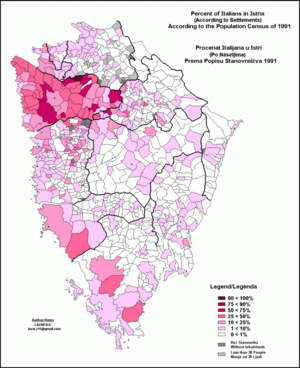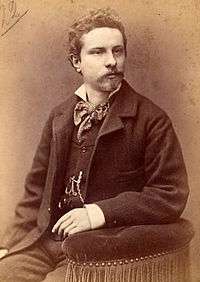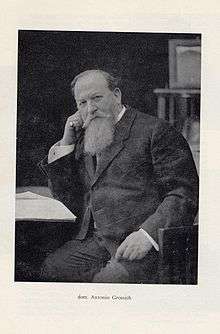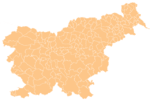Istrian Italians
Istrian Italians are an ethnic group in the northern Adriatic region of Istria, related to the Italian people of Italy. Historically they are descendants from the original Latinized population of Roman Istria, from the Venetian-speaking settlers who came to Istria during the time of the Republic of Venice, and from the South Slavic population in Istria that culturally assimilated to the Latins.[1] Today, as a result of the Istrian exodus, the majority of Istrian Italians live outside of the Istrian peninsula; however, a significant Italian minority still lives in the Croatian County of Istria (6.92%) and in Slovenian Istria, where they are granted minority rights. According to the official Slovenian and Croatia censuses conducted in 2001 and 2002 their number is around 22,000. The Istrian diaspora, on the other hand, numbers more than 200,000 people.
The number of people resident in the Croatian part of Istria declaring themselves to be Italian nearly doubled between 1981 and 1991 (i.e. before and after the dissolution of Yugoslavia).[2]
History
Early period
Historian Theodor Mommsen wrote that Istria (the X region of Roman Italia since Augustus) was fully romanized in the 5th century AD.[3]
Between 500 and 700 AD, Slavs settled in Southeastern Europe (Eastern Adriatic), and their number ever increased, and with the Ottoman invasion Slavs were pushed from the south and east.[4] This led to Italic people becoming ever more confined to urban areas, while some areas of the countryside were populated by Slavs, with exceptions in western and southern Istria which remained fully Romance-speaking.[5]
By the 11th centuries, most of the interior mountainous areas of northern and eastern Istria (Liburnia) were inhabited by South Slavs, while the Romance population continued to prevail in the south and west of the peninsula. Linguistically, the Romance inhabitants of Istria were most probably divided into two main linguistic groups: in the north-west, the speakers of a Rhaeto-Romance language similar to Ladin and Friulian prevailed, while in the south, the natives most probably spoke a variant of the Dalmatian language.
One modern claim suggests the original language of the romanized Istrians survived the invasions, this being the Istriot language which spoken by some near Pula).[6] Venice influenced the neolatins of Istria for many centuries from the Middle Ages until 1797, until conquered by Napoleon: Capodistria and Pola were important centers of art and culture during the Italian Renaissance.[7] Other historians have attributed the ancient language of romanized Istrians as being the Istrorumeno.
Venetian rule
In the 14th century, epidemics such as the Black Death decimated in those years the Istrian population, which was still mostly of Romance ethnicity. As a consequence of depopulation, Venice started settling Slavic communities to repopulate the interior areas of the peninsula. These were mostly Čakavian and partially Štokavian speaking South Slavs from Dalmatia and present-day Montenegro (differently from Kajkavian and proto-Slovene speakers that lived in the northern areas of the peninsula).
At the same time, settlers from the Veneto region were used to resettle the towns. This caused a language shift of the local Romance population who replaced the old Romance (either Rhaeto-Romance or Italo-Dalmatian) languages with the Venetian dialect of Italian. Only in the extreme south of the peninsula did the original Istrian Romance language survive: under strong Venetian influences it transformed itself into the modern Istriot language. Until the early 19th century, Dalmatian continued to be spoken on the island of Veglia / Krk, and a dialect of Friulian in the town of Muggia: both became extinct in the mid 19th century, replaced by Venetian.
In 1374 Because of the implementation of a treaty of inheritance, central and eastern Istria fell to the House of Habsburg, while Venice continued to control the northern, western and south-eastern portion of the peninsula, including the major coastal towns of Capodistria / Koper, Parenzo / Poreč, Rovigno / Rovinj, Pola / Pula, Fianona / Plomin, and the interior towns of Albona / Labin and Pinguente / Buzet.[8] This created a dichotomy that characterized Istria until the late 18th century. The Venetian culture and language left a profound impact on Venetian Istria. By the Baroque and Enlightenment periods, Istrian Italians were completely integrated in the wider Italian culture via their belonging to the Republic of Venice. The towns of Venetian Istria became almost exclusively Venetian-speaking, and Venetian Italian was the language of commerce, culture and administration. Nevertheless, significant numbers of South Slavic speakers (mostly Slovene and Čakavian Croatian) continued to dwell in the rural areas of Venetian Istria, especially in the north of the province and on the border with Austrian Istria.
On the other hand, interior and eastern Istria was included into the Central European cultural sphere and were dominated by a feudal culture. By the late 18th century, the vast majority of Austrian Istria were Slavic (Slovene and Croat) speakers.
After the Treaty of Campo Formio (1797) Austria occupied the Venetian part of the peninsula. After a short French interim, Austria reconquered the whole peninsula in 1813, and unified it into a single province. As a result, Istrian Italians became a minority in the new administrative unit, although they maintained their social and part of their political power.
Austrian period
Although the incorporation into the Austrian Empire caused deep changes in the political asset of the region, it did not alter the social balance. Venetian-speaking Istrian Italians continued to dominate the region both culturally and economically. In the first half of the 19th century, the use of Venetian language even extended to some areas of former Austrian Istria, like the town of Pazin / Pisino. The Austrian censuses detected a gradual but constant rise of Italian speakers both in numerical and proportional terms: in 1848, around a third of Istrians were Italian (Venetian or Istriot) speakers.
From the early 19th century onward, the local Croats and Slovenes engaged in a national revival, demanding linguistic and national rights that challenged the supremacy of the Italian language and culture in Istria. The Croatian-Slovene national movement gained force only in the second part of the 19th century, causing a clash with a parallel nationalist movement of the Istrian Italians.[9]
Many Istrian Italians looked with sympathy towards the Risorgimento movement that fought for the unification of Italy. However, after 1866, when the Veneto and Friuli regions were ceded by the Austrians to the newly formed Kingdom Italy, Istria remained part of the Austro-Hungarian Empire, together with other Italian-speaking areas on the eastern Adriatic (Trieste, Gorizia and Gradisca, Fiume). This triggered the gradual rise of Italian irredentism among many Italians in Istria, who demanded the unification of the Austrian Littoral, Fiume and Dalmatia with Italy.
Under Austrian rule in the 19th century, it included a large population of Italians, Croats, Slovenes, some Vlachs/Istro-Romanians and even a few Montenegrins. The Italians in Istria supported the Italian Risorgimento: as a consequence, the Austrians saw the Italians as enemies and favored the Slav communities of Istria [10] This fact created a huge emigration of Italians from Istria before World War I, reducing their percentage inside the peninsula inhabitants (they were more than 50% of the total population during Napoleonic times (when General Marmont did a French census), but at the end of the 19th century they were reduced to only two fifths according to some estimates).
On the other hand, the Istrian Slovenes and Croats, who represented around three fifths of the Istrian population, increased their demands for national and linguistic emancipation. The result was the intensification of the ethnic strife between the two groups, although it was limited to institutional battles and it rarely manifested in violent forms.
Indeed, in 1910, the ethnic and linguistic composition was completely mixed and the Italians were reduced to minority, although still significant. According to the Austrian census results, out of 404,309 inhabitants in the "Margravate of Istria", 168,116 (41.6%) spoke Croatian, 147,416 (36.5%) spoke Italian, 55,365 (13.7%) spoke Slovene, 13,279 (3.3%) spoke German, 882 (0.2%) spoke Romanian, 2,116 (0.5%) spoke other languages and 17,135 (4.2%) were non-citizens, which had not been asked for their language of communication.
But scholars like Matteo Bartoli complained that these census percentages included areas outside Istria (like the island of Veglia/Krk and the city of Castua/Kastav, a mostly Croatian town situated north of Fiume and outside the real Istrian peninsula). He considers that the peninsula of Istria was still with a majority of Italians during World War I.[11] Generally speaking, Italians lived on coast, while Croats, Slovenes and the dwindling numbers of Istro-Romanians mainly lived inland.
Until the end of the Austro-Hungarian Monarchy, the bourgeois Italian national liberal elites retained much of the political control in Istria.
Under Italy
During World War One, many Istrians fought as volunteers on the Italian side against the Austro-Hungarian Empire. Among them, the most famous was the Nazario Sauro from Koper (Capodistria).[12]
After the end of the war, the whole peninsula was occupied by the Kingdom of Italy, and officially annexed to Italy with the Treaty of Rapallo of 1920. Istria was included in the administrative region known as the Julian March/Venezia Giulia. After the Fascist takeover of Italy in 1922, Italian became the sole language of administration and education. A fierce policy of Italianization was followed which prohibited all use of any language but Italian. Many Slovenes and Croats left the region, which strengthened the Italian positions. However, ethnic tensions grew, and a Slovenian and Croatian anti-Fascist insurgency started to appear in the late 1920s, although it was much less stronger than in other parts of the Julian March.
Indeed, before the Treaty of Rapallo, the Italians in Istria accounted for nearly half of the local inhabitants and were mostly an indigenous population, but after the treaty they were bolstered by some new arrivals of the so-called regnicoli (from the Kingdom of Italy), never well liked[13] by the indigenous Istrians Italians.
The Austrian 1910 census indicated approximately 182,500 people who listed Italian as their language of communication in what is now the territory of Slovenia and Croatia: 137,131 in Istria and 28,911 in Fiume/Rijeka (1918).[14] Meanwhile, the Italian 1936 census[15] indicated approximately 230,000 people who listed Italian as their language of communication (in what is now the territory of Slovenia and Croatia, then part of the Italian state): nearly 194,000 in today’s Croatia and 36,000 in today’s Slovenia.
World War Two and its consequences
After the Italian armistice of 1943, Istria became a battlefield between the Nazi German army and the partisan (mostly Yugoslav) insurgency. Already in September 1943, several hundreds Istrian Italians were killed by the Yugoslav partisans because of their allegiance to the Italian State. This was the first wave of the Foibe massacres, which continued after the Yugoslav takeover of the region in May 1945.
From 1943 until 1953, according to various data, between 200,000 and 330,000 Italians emigrated from these regions. This emigration of Italians (called Istrian exodus) reduced the total population of the region and altered its ethnic structure.
After the Yugoslav Communist troops occupied Istria in May 1945, many Italians started leaving Istria under the pressure of the new authorities who demanded the annexation of Istria to Yugoslavia. With an agreement between the Allied forces and Tito's Yugoslav government, a line of demarcation known as the Morgan Line was set in June 1945: most of Istria remained under Yugoslav occupation, while the towns of Pula and Muggia were transferred to Allied administration.
With the peace treaty of 1947, most of Istria (including Pula) was assigned to Yugoslavia. This triggered the Istrian exodus, the departure of the large majority of Istrian Italians. Only the north-western portion was assigned to the zone B of the short-lived Free Territory of Trieste, but de facto remained under Yugoslav administration.
Part of Yugoslavia
In 1953 according to the official census only 36,000 Italians lived in Yugoslavia, 16% of the Italian population before World War II,[16] and another 35,000 lived in the zone B of the Free Territory of Trieste (FTT). After the dissolution of the FTT in 1954, and the definitive hand-over of the zone B to Yugoslavia, almost the totality of Istria became officially part of Yugoslavia. This triggered the last wave of the Istrian exodus, with most of the Istrian Italians[17][18] leaving the zone B for elsewhere (mainly to Italy) because intimidated or preferring not to live in communist Yugoslavia. Yugoslav Istria was divided between Croatia and Slovenia, so that the Istrian Italians became subject to two different administrations.
In 1961 25,651 Italians remained in Yugoslavia (this number included some small minorities in Dalmatia), around 10-12% of the Italian population before World War II. Italians continued to emigrated in later decades (most of them to Australia, Canada, South America or the USA). Therefore, their population declined in each subsequent census to 15,132 inhabitants in 1981.
It has to be emphasized that the data of the Yugoslav censuses are unreliable in relation to the real number of Italians, since many members of the Italian minority, for various reasons, chose to be nationally undeclared or preferred to use their regional identity and declared themselves as Istrians. Not surprisingly in 2001 (i.e. after the dissolution of Yugoslavia), the Croatian and Slovenian censuses reported a total Italian population of 21,894 (with the figure in Croatia nearly doubling).
In its 1996 report on 'Local self-government, territorial integrity and protection of minorities' the Council of Europe's European Commission for Democracy through Law (the Venice Commission) put it that "a great majority of the local Italians, some thousands of Slovenes and of nationally undefined bilingual 'Istrians', used their legal right from the peace treaty to 'opt out' of the Yugoslav controlled part of Istria". In several waves they moved to Italy and elsewhere (also overseas, mainly in the Americas) and claimed Italian or other citizenship.
Current situation
Today Istrian Italians are mostly a national minority in Croatia. Croatian municipalities with a significant Italian population include Grisignana / Grožnjan (51%), Verteneglio / Brtonigla (37%), and Buie / Buje (40%).[19]
The last census (2001) show that there are nearly 50,000 Istrian Italians in entire Istria (between Croatia, Slovenia and Italy):[20]
| Municipality | Other name | Country | Inhabitants | Mother tongue Italian | Mother tongue Croatian and Slovenian |
|---|---|---|---|---|---|
| Labin, city | Albona | 12426 | 03.09% | 92.62% | |
| Buje, city | Buie | 5340 | 39.66% | 53.76% | |
| Novigrad, city | Cittanova | 4002 | 15.32% | 77.59% | |
| Vodnjan, city | Dignano | 5651 | 19.93% | 73.16% | |
| Poreč, city | Parenzo | 17460 | 06.42% | 87.12% | |
| Buzet, city | Pinguente | 6059 | 00.87% | 96.63% | |
| Pazin, city | Pisino | 9227 | 01.21% | 97.56% | |
| Pula, city | Pola | 58594 | 04.87% | 88.38% | |
| Rovinj, city | Rovigno | 14234 | 10.81% | 81.85% | |
| Umag, city | Umago | 12901 | 20.70% | 72.87% | |
| Bale | Valle | 1047 | 22.54% | 75.36% | |
| Barban | Barbana d'Istria | 2802 | 00.39% | 99.21% | |
| Brtonigla | Verteneglio | 1579 | 41.29% | 52.83% | |
| Cerovlje | Cerreto | 1745 | 00.46% | 99.31% | |
| Fažana | Fasana | 3050 | 04.66% | 90.75% | |
| Gračišće | Gallignana | 1433 | 00.28% | 99.16% | |
| Grožnjan | Grisignana | 785 | 66.11% | 29.17% | |
| Kanfanar | Canfanaro | 1457 | 01.51% | 96.23% | |
| Karojba | Caroiba del Subiente | 1489 | 00.94% | 97.99% | |
| Kaštelir-Labinci | Castellier-Santa Domenica | 1334 | 07.80% | 88.23% | |
| Kršan | Chersano | 3264 | 00.40% | 94.49% | |
| Lanišće | Lanischie | 398 | n.p. | 98.99% | |
| Ližnjan | Lisignano | 2945 | 08.05% | 88.29% | |
| Lupoglav | Lupogliano | 929 | 00.32% | 98.82% | |
| Marčana | Marzana | 3903 | 00.74% | 97.72% | |
| Medulin | Medolino | 6004 | 03.05% | 89.77% | |
| Motovun | Montona | 983 | 15.46% | 81.28% | |
| Oprtalj | Portole | 981 | 32.11% | 65.04% | |
| Pićan | Pedena | 1997 | 00.95% | 98.05% | |
| Raša | Arsia | 3535 | 02.63% | 94.29% | |
| Sveta Nedelja | Santa Domenica d'Albona | 2909 | 01.51% | 97.32% | |
| Sveti Lovreč | San Lorenzo del Pasenatico | 1408 | 01.49% | 96.38% | |
| Sveti Petar u Šumi | San Pietro in Selve | 1011 | 00.30% | 99.21% | |
| Svetvinčenat | Sanvincenti | 2218 | 01.17% | 97.16% | |
| Tinjan | Antignana | 1770 | 00.79% | 98.59% | |
| Višnjan | Visignano | 2187 | 08.78% | 89.44% | |
| Vižinada | Visinada | 1137 | 08.36% | 90.59% | |
| Vrsar | Orsera | 2703 | 02.96% | 90.75% | |
| Žminj | Gimino | 3447 | 01.28% | 97.80% | |
| Muggia | Milje | 13208 | 94.80% | 04.80% | |
| San Dorligo della Valle | Dolina | 6025 | 29.20% | 70.50% | |
| Koper, city | Capodistria | 49206 | 02.22% | 74.14% | |
| Izola | Isola | 14549 | 04.26% | 69.13% | |
| Piran | Pirano | 16758 | 07.00% | 66.69% | |
| Lovran | Laurana | 3987 | 01.71% | 92.65% | |
| Opatija, city | Abbazia | 12719 | 04.64% | 93.81% | |
| Mošćenička Draga | Draga di Moschiena | 1641 | 00.91% | 95.67% | |
Source: Croatian Census - 2001.[21] Slovenian Census - 2002.[22] Italian Census - 1970/2001[23][24]
Contribution of Istrian Italians
Across the centuries the contribution of Istrian Italians in different fields has been significant.
Science
- Santorius Santorio, inventor of clinical thermometer and physician
- Antonio Grossich, surgeon
Music and arts
- Francesco Trevisani, Rococo painter
- Andrea Antico, music editor and composer of the Renaissance
- Antonio Smareglia, opera composer
- Giuseppe Tartini, music composer and violinist
- Villi Bossi, sculptor
- Giorgio Surian, opera singer
- Leonora Surian, actress
- Sergio Endrigo, singer-songwriter
Literature and writing
- Pier Paolo Vergerio, Reformer and Humanist
- Fulvio Tomizza, international writer
- Giovanni Arpino, writer and journalist
- Lidia Bastianich, chef, author and restaurateur
- Sergio Endrigo, singer-songwriter
Politics
- Vittorio Vidali, politician
- Aurelio Juri, politician, Member of European Parliament
- Pietro Polani, Doge of Venice
Cinema
- Laura Antonelli, international film actress
- Alida Valli, international film actress
- Femi Benussi, national film actress
Sport

- Nino Benvenuti, professional boxing champion, Olympic gold medal in 1960
- Giovanni Cernogoraz, shooter, Olympic gold medal in 2012
- Mario Andretti, international automobile racing driver
- Sigrid Corneo, Slovenian cyclist (Italian father)
- Elvis Scoria, football manager
- Fausto Budicin, football player
- Mitja Gasparini, Slovenian volleyball player.
- Simon Sluga, Croatian footballer
- Eva Mori, Slovenian volleyball player
- Samanta Fabris, Croatian volleyball player
War
- Nazario Sauro, Italian patriot and irredentist
- Spartaco Schergat, Frogman and hero of WWII
Others
- Lidia Bastianich, chef
- Joe Bastianich, chef
See also
- Istria
- Istrian exodus
- Free Territory of Trieste
- Dalmatian Italians
- Istriot language
- Istro-Romanian language
Notes
- ↑ History of Istria: Slavs and Latins (in Italian)
- ↑ The political, ethnic and linguistic borders of the upper Adriatic after the dissolution of Yugoslavia, J.E. Jahn, Heidelberg Germany 1999
- ↑ Theodore Mommsen. The Provinces of the Roman Empire.Chapter I.
- ↑ "Demography and the Origins of the Yugoslav Civil War".
- ↑ Jaka Bartolj. "The Olive Grove Revolution". Transdiffusion.
While most of the population in the towns, especially those on or near the coast, was Italian, Istria’s interior was overwhelmingly Slavic – mostly Croatian, but with a sizeable Slovenian area as well.
- ↑ Istrioto, the autochthonous language of southern Istria (in Italian)
- ↑ Prominent Istrians
- ↑ Antolini, Nicola. Slavi e Latini in Istria tra cinquecento e novecento: origini storiche e problemi del contesto multietnico istriano.First section
- ↑ Benussi, Bernardo. L' Istria nei suoi due millenni di storia. p. 63
- ↑ Paolo Radivo: Italian Irredentism in Istria (in Italian)
- ↑ Bartoli, Matteo. Le parlate italiane della Venezia Giulia e della Dalmazia. p. 44
- ↑ Biography of Nazario Sauro
- ↑ Angelo Visintin. "L'assalto a "Il Piccolo" / Napad na "Il Piccolo"". In Sergio Zucca. Un percorso tra le Violenze del Novecento nella Provincia di Trieste / Po Poteh Nailja v 20. Stoletju v Tržaški Pokrajini [A journey through the violence of the twentieth century in the Province of Trieste] (PDF) (in Italian and Slovenian). p. 24. ISBN 88-95170-02-4.
- ↑ O.Mileta Mattiuz, Popolazioni dell'Istria, Fiume, Zara e Dalmazia (1850-2002). Ipotesi di quantificazione demografica, ADES 2005, pp. 57, 128, 159, 169
- ↑ VIII. Censimento della popolazione 21. aprile 1936. Vol II, Fasc. 24: Provincia del Friuli; Fasc. 31: Provincia del Carnero; Fasc. 32: Provincia di Gorizia, Fasc. 22: Provincia dell’Istria, Fasc. 34: Provincia di Trieste; Fasc. 35: Provincia di Zara, Rome 1936. Cited at Citizenship in historical perspective, edited by Steven G. Ellis, Guðmundur Hálfdanarson and Ann Katherine Isaacs
- ↑ Matjaž Klemenčič, The Effects of the Dissolution of Yugoslavia on Minority Rights: the Italian Minority in Post-Yugoslav Slovenia and Croatia
- ↑ Arrigo Petacco, The exodus. The story of the Italian population of Istria, Dalmatia, and Venezia Giulia, Mondadori, Milan, 1999. English translation.
- ↑ US Intelligence Review on Istria / Venezia Giulia after WWII
- ↑ See census data from Croatia at http://www.dzs.hr/default_e.htm --> released data --> census 2001 --> tables --> population by mother tongue by towns/municipalities --> (scroll down) County of Istria
- ↑ Pradelli, A. Il silenzio di una minoranza: gli italiani in Istria dall'esodo al post-comunismo 1945–2004. p. 38
- ↑ Croatian census - 2001. Press Released Data, Censuses and look for the table: Population by Mother Tongue, by Towns/Municipalities
- ↑ Slovenian Census - 2002
- ↑ ISTAT, 14° censimento generale della popolazione e delle abitazioni 2001. Popolazione residente e abitazioni nelle province italiane - fascicolo provinciale Trieste, Roma, 2005 - (this is the official book from the Italian Istituto Centrale di Statistica (Central/National Institute of Statistics) about the census)
- ↑ Statistical and ethnographic study about the Slovene in the Provincia di Trieste. Scroll down for the data table
Bibliography
- Antolini, Nicola. Slavi e Latini in Istria tra cinquecento e novecento: origini storiche e problemi del contesto multietnico istriano. Magazine "Storicamente". n. 2, 2006
- Bartoli, Matteo. Le parlate italiane della Venezia Giulia e della Dalmazia. Tipografia italo-orientale. Grottaferrata 1919.
- Benussi, Bernardo. L' Istria nei suoi due millenni di storia. Treves-Zanichelli. Trieste 1924.
- Mommsen Theodore. The Provinces of the Roman Empire. Barnes & Noble Books. New York, 1996 ISBN 0-7607-0145-8
- Perselli, Guerrino. I censimenti della popolazione dell'Istria, con Fiume e Trieste, e di alcune città della Dalmazia tra il 1850 e il 1936. Centro di ricerche storiche - Rovigno, Trieste - Rovigno 1993.
- Pirjevec, Jože; Kacin-Wohinz, Milica. Storia degli sloveni in Italia, 1866-1998. Marsilio, Venezia 1998.
- Petacco, Arrigo. L'esodo, la tragedia negata degli italiani d'Istria, Dalmazia e Venezia Giulia. Mondadori, Milano, 1999.
- Pradelli, A. Il silenzio di una minoranza: gli italiani in Istria dall'esodo al post-comunismo 1945–2004. Lo Scarabeo Editoriale. Bologna, 2004.
- Seton-Watson, Italy from Liberalism to Fascism, 1870-1925. John Murray Publishers, Londra 1967.
- Vignoli, Giulio. I territori italofoni non appartenenti alla Repubblica Italiana. Giuffrè, Milano, 1995.
- Tomaz, Luigi. Il confine d'Italia in Istria e Dalmazia. Duemila anni di storia. Think ADV, Conselve 2007.
External links
- Slavs and Latins in Istria (Italian)
- Arrigo Petacco: "The exodus. The story of the Italian population of Istria (1943-1956)" (English translation).
- Official website of bilingual Groznan/Grisignana (Croatian) (Italian)
- Official website of Italians (Istrian exodus) from Piemonte d'Istria-Grisignana (Italian)
- Official Website of the Italian community in Croatia and Slovenia (Italian)
- Centro Ricerche Storiche di Rovigno: "Istria nel Tempo on line" (in Italian)



